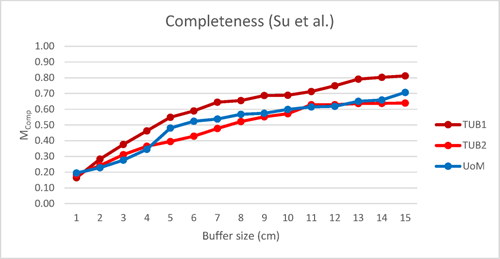Submission name:
Su et al.
Short description of the method:
The proposed method uses raw point clouds as inputs and consists of two main steps: comprehensive segmentation and indoor reconstruction. Comprehensive segmentation contains two parts: story segmentation and room segmentation.
- Story segmentation: The origin data are partitioned into multiple stories and the connected area across floors with a histogram that describes the distribution of points along the z-axis.
- Room segmentation: The points in each story are split into several slices. Then, cells are partitioned by extended wall line segments, which are extracted by a region-growing line extraction algorithm followed by a line fusion algorithm. The iterative reweighted least-squares (IRLS) algorithm is used for line fitting in the processing of region-growing. In the meantime, the room-space in each story is segmented by using the morphological erosion method after projection onto a horizontal plane and cutoff connection between rooms through projecting the offset space from ceiling height. Finally, the rooms in each story are segmented by overlapping the segmented room-space with cell decomposition. The corridor is labeled via a connection analysis between rooms on each floor. A room that connects more than three rooms and locates in the center of the connected map is labeled a corridor.
- Indoor reconstruction: The height of each story and connected areas is extracted via the histogram from the previous step. To obtain an accurate height of each room in each story, the height of ceiling and floor in each room has been recalculated via the ceiling plane and floor plane, which are extracted from by RANSAC method in each room. The doors’ locations in each room or corridor are determined by a horizontal connected analysis. The planes on stairs are extracted by using a region-growing plane-extraction method and rebuilt by using an arithmetic progression calculation for the height, length and width of one stair. All story and stair models are merged into a connected area model through the models’ coordinates. The final model is rebuilt after deleting shared areas through union operator in the merged models.
Reference:
Li, L., Su, F., Yang, F., Zhu, H., Li, D., Zuo, X., Li, F., Liu, Y., and Ying, S., 2018. Reconstruction of three-dimensional (3D) indoor interiors with multiple stories via comprehensive segmentation. Remote Sensing, 10(8), 1281.
URL:
Not provided.
Submission date:
25 Dec. 2019
Last update:
25 Dec. 2019


